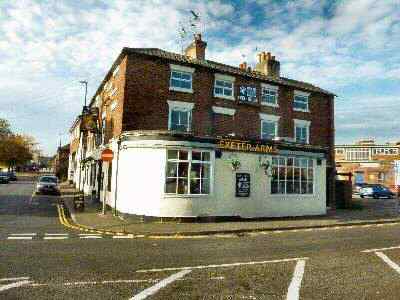CATHEDRAL QUARTER TRAILS - MARKET HALL
CATHEDRAL QUARTER AND BEYOND – 8 MARKET HALL
Stylish, independent shops, great places to eat and drink, valued professional services and impressive historical landmarks; Derby’s Cathedral Quarter has it all.
Market Hall
The covered Market Hall has adapted to changing circumstances and there has been a growth of service stalls. In 1926 the Fish Market was moved and relocated to the south side of the Market Hall. It is now sited in Lock-up Yard. There is a Poultry Market in an annexe.

The interior of the Market Hall was completely refurbished in 1938, resulting in the elegant balcony being boarded up. In July 1987, the Market Hall was closed for major repairs and renovation. The objectives were modernisation and the need to return it to its original appearance as a Victorian-listed building. It was reopened by HRH Princess Margaret in 1989 and is the home to many long-established traders.
As you leave the Market Hall at the southern end, Osnabruck Square is entered. The square was named when Derby was twinned with Osnabruck in 1985. Town/city twinning was started after the Second World War. As a means of building strong links and friendships between similar-sized towns/cities abroad. Special emphasis is placed on young people’s involvement and exchanging ideas to benefit local communities.
Market Hall (interior)

The covered Market Hall hides behind the Guildhall and is one of Derby’s greatest treasures. It is a fine example of Victorian architecture. With a spectacular vaulted roof, using iron supplied by a nearby foundry. Inside, there is a wealth of unusual, classic and traditional stalls, shops and café bars. It cost £29,000 to build and was officially opened on 29 May 1866, by the Mayor, Frederick Longdon. At the opening ceremony, the Duke of Devonshire gave a speech. There were parades through the town and a choir of 600 performed the ‘Messiah’.
At that time the hall contained 38 butcher shops and 150 stalls. For sale were flowers, fruit, vegetables, books, newspapers, groceries, jewellery, sewing machines, sweets and toys. On the balcony, there were refreshment stalls and several drapers.
One problem was that when the weather was wintry both traders and shoppers felt bitterly cold as the Market Hall had no doors. However, following a deputation from the stallholders, the markets committee agreed to fit them.
Osnabruck Square

Today when you leave the Market Hall by the doors at the southern end you reach Osnabruck Square. It is named after Derby’s twin city in Germany. A stone pillar in the centre of the square announces that the German city is 500 miles away. Osnabruck was founded in 780AD, and has many historic buildings, like Derby. Also, it is close to the countryside. As a result of the twinning arrangements, many events and activities have taken place connecting the two cities. The fish market that once stood in the square was demolished in 1981 and relocated to the Lock-up Yard.
Albert Street
Albert Street was named after HRH Prince Albert and came into existence when Markeaton Brook was culverted. The most prominent building in the street is the Old Corn Exchange It was once the home of the Derby Evening Telegraph.
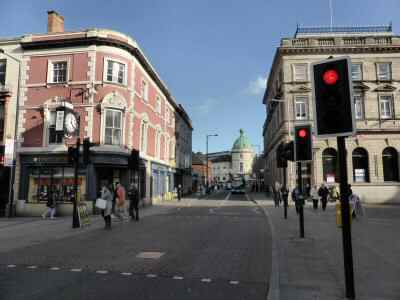
After nearly 50 years of costly circulation wars. The Derby Telegraph as it is now titled merged with its rival, The Express, on 29 January 1932. The Express was owned by Allied Northern Newspapers, and Northcliffe Newspapers owned the Derby Telegraph. Both papers combined and the joint paper was published at Northcliffe House, the new name given to the Corn Exchange. As new technology was introduced, it became obvious the building was too small to accommodate all the equipment. And the move to new premises, on the banks of the River Derwent, began at the end of 1979. The newspaper moved again in November 2014 to Siddals Road much closer to the city centre.
Sir Peter Hilton Memorial Gardens
The Sir Peter Hilton Memorial Garden is located to the east of Market Place, behind the Quad building. It is dedicated to Colonel Sir Peter Hilton, who was a much-decorated veteran of the Second World War. He later became Lord Lieutenant of Derbyshire, a position he held from 1978 to 1994.
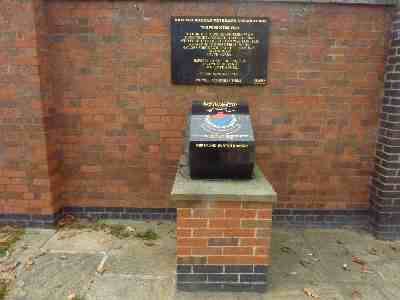
There is a stone memorial to the Derby British Korean Veterans in the garden, celebrating the 50th anniversary of the ceasefire. It is inscribed “In memory of those who gave their lives in the Korean war” and bears the dates 1950 and 1953 and the words “Not one of them is forgotten before God”. Also, there is a small plaque dedicated to the memory of Colonel Sir Peter Hilton, who died in 1995.
The centrepiece of the sunken garden is the statue of a “Boy and Goose” surrounded by raised flower beds. The bronze statue was originally known as the “Boy and Gander” and it has stood in several locations in the centre of Derby.
THE TRAIL NOW LEAVES THE CATHEDRAL QUARTER
Council House
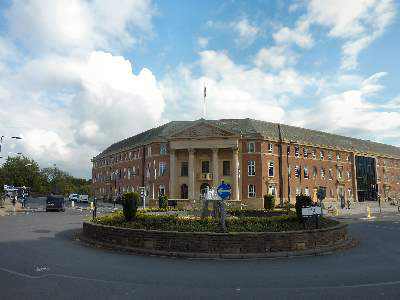
Construction of the Council House began in 1938 and was scheduled for completion in 1941. But on the outbreak of the Second World War, work stopped immediately. It was allowed to resume the following year and in 1942, with the building nearly complete. The Government took it over for the war effort and it was occupied by the Royal Air Force. They remained there until 1946.
The official opening of the Council House took place on 27 June 1949. When the ceremony was performed by Princess Elizabeth and her husband, Prince Philip. The Princess was handed a silver-gilt key by Alderman Raynes, with which she officially opened the building. However, the building was not fully finished and it was not until 21 October 1954. When the council chamber was finally finished and opened, by Alderman W R Raynes. This was a particularly symbolic date as Derby was celebrating its 800th anniversary that year. Since Henry II granted Derby’s first charter to hold markets and fairs.
After two years of refurbishment costing £32 million. Derby’s Council House was officially reopened to the public on 17 December 2012. Behind the floor-to-ceiling glazed entrance, the interior of the building is light and airy.
Riverside Gardens
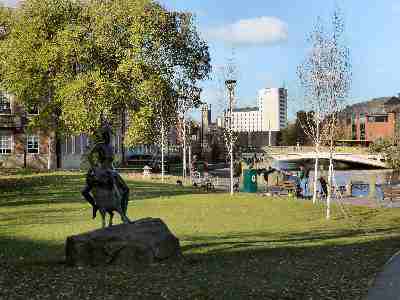
The River Gardens and Water Lily Pool were opened to the public in 1933. Although the official opening ceremony did not take place until the following year. The Council House was not built until several years later, but the covered market on the Morledge side of the Council House was opened on 5 May 1933. The gardens have changed considerably from the original design, which included a large formal pond planted with lilies complete with two large bronze turtle sculptures. Further changes have been made to the gardens as part of the flood avoidance plan. Including the return of the turtles that had been located at Allestree Hall for several years.
Exeter Bridge
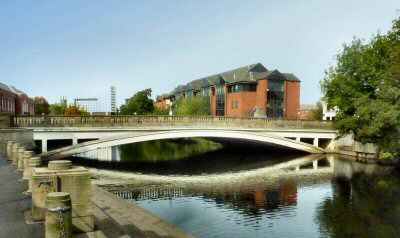
In the former days, Canary Island was part of the east bank of the Derwent bounded by the canal and the river. It was the location of the gardens of the wealthy people who lived on Full Street. The problem was that to get to the gardens most families had to use St Mary’s Bridge, which they considered an inconvenience.
Erasmus Darwin, who lived at 3 Full Street, constructed a hand-operated ferry. The Binghams of Exeter House, now demolished, built a wooden bridge across the river. As the bridge served Exeter House, it was soon named Exeter Bridge. After Jedediah Strutt bought the house, it was opened up to the general public, but remained in private ownership.
After Strutt’s death, the bridge was widened and later taken over by Derby Corporation. They proposed further improvements and opened it as a public road. After this had taken place it remained intact, until 1929. When it was demolished and replaced by a single-span concrete bridge. Designed by Charles Herbert Aslin of the Council Architect’s Department. It was opened on 13 March 1931 by the Rt Hon Herbert Morrison MP.
Engraving plaque of Erasmus Darwin
There are four Bas Relief Engravings on the corners of Exeter Bridge. They are Erasmus Darwin, William Hutton John Lombe and Herbert Spencer. Darwin was respected as a doctor throughout the land and tried to pioneer free medical advice for the poor. He was probably the greatest visionary of his age and had success in many fields. Darwin re-established the Derby Philosophical Society, where the greatest and most creative minds in the country could exchange ideas. Hutton rose from poverty to become a man of eminence, as a historian, poet and businessman. After setting up a bookshop in Southwell, Nottinghamshire he started to write, his autobiography. Giving an important insight into working-class conditions in 18th-century Derby.
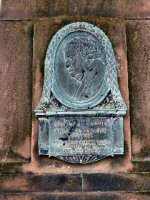
Lombe tried to assist Thomas Cotchett, a solicitor and businessman to produce fine silk to rival that imported from Italy. The mission failed and Lombe decided there was nothing else for it. But to go to Italy and acquire the jealously guarded secrets. On his return, assisted by his half-brother, Thomas, he set up the Silk Mill. Spencer, born in Exeter Street, achieved great fame for his works on philosophy developing an all-embracing concept of evolution.
Exeter Arms
A purpose-built Regency-style pub, erected around 1816, at about the same time as the rest of the area. The pub took its name from the Earl of Exeter whose home, Exeter House, stood nearby. The house was demolished, in 1854.
Due to an unfortunate error, the sign illustrates the arms of the city of Exeter. In recent years the pub has won numerous prestigious awards including the Food and Drink Pub of the year award. Further accolades have followed in subsequent years.
